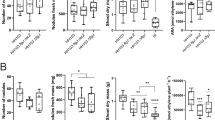Abstract
Following transposon Tn5 mutagenesis of the plant growth-promoting rhizobacterium Pseudomonas putida GR12-2, mutants that have different freeze-resistant properties were selected. Five of the freeze-sensitive mutants, i.e. FSM-5, -6, -14, -29, and -41, secreted a lower amount of antifreeze protein-(AFP) into the culture broth compared with the wild-type. Among of these five mutants, the three mutants (FSM-6, FSM-14, and FSM-41) that have the lowest level of freezing resistance (4.0–6.0% survival) also produce AFP at low levels (0.5–0.9 μg/mL) compared with the wild-type (4.8 μg/ml). The antifreeze and ice-nucleating activities of the AFP from these three mutant strains were similar to those of wild-type. Furthermore, the decreased freezing resistance from three mutants could be partially restored by adding purified AFP to mutant cell suspensions. Freezing resistance of three mutants was found to increase in proportion to the addition of AFP up to a concentration of 50 μg/mL. We conclude that accumulation of AFP is one component of the mechanism for freezing resistance in bacteria.
Similar content being viewed by others
Author information
Authors and Affiliations
Additional information
Received: 18 December 2000 / Accepted: 12 April 2001
Rights and permissions
About this article
Cite this article
Kawahara, H., Li, J., Griffith, M. et al. Relationship Between Antifreeze Protein and Freezing Resistance in Pseudomonas putida GR12-2. Curr Microbiol 43, 365–370 (2001). https://doi.org/10.1007/s002840010317
Published:
Issue Date:
DOI: https://doi.org/10.1007/s002840010317




